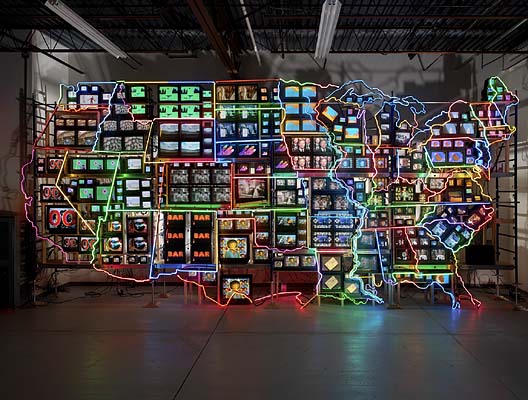Electronic Superhighway
When I went to the American Art Museum, no one seemed to know to which collection I was referring, despite inquiring with several security guards and the information desk. So, I wandered around myself trying to find it and came upon Electronic Superhighway (1995) by Nam June Paik. The piece is film-based and experimental, featuring each of the 50 states outlined in neon, with 50 closed-circuit television channels. Each channel features something that reminded the artist of the state. The artist was a Korean immigrant whose family fled Seoul during the war, after which he lived in Hong Kong, Japan, and Germany before settling in the United States. With so many cultural influences, his interpretations likely benefit from being more original and unbiased than if the artist had been born and raised in the US.
Each state is outlined in neon, with televisions within the outlines that each show the same thing. Some screens are tilted to better fit the state (such as within New Jersey and Maryland), and television size varies depending upon the size of the state. Colorado and New Mexico, for example, each have six televisions of equal size, while Wisconsin’s vary and some are tilted to fit the shape of the state. Selections vary– some are tributes to artist friends, Iowa’s is what appears to be a tourism commercial of some sort featuring celebrities and a number of politicians such as Jimmy Carter and Gerald Ford, which is perhaps an homage to Iowa’s essential role in our political nomination process. Kansas plays The Wizard of Oz and Missouri’s is Meet Me in St. Louis– maybe the artist was an avid Judy Garland fan? Oklahoma’s could be nothing else but Oklahoma!, and that is the film the artist selected. Others are more subjective. For Maine, he chose an homage specifically to an artist friend, and New York is not representative of the whole state, but rather an image of the Empire State Building (although I suppose New York City is all most people think about when they think “New York”).
The artist’s background is what really makes this piece unique. Such an elaborate undertaking can really only be accomplished by a person for whom America is an adopted homeland. His impressions are all his own, not influenced by the part of America in which one grew up, or stereotypes learned from one’s family. Too many of us take living in the United States for granted. For myself and others, the privilege of calling oneself “American” is a birthright, not something that had to be earned, but each of our families at some point struggled to make it in the United States.
I wish some elements of the piece were more objective. For example, there were several states (though Maine is the only one I specifically remember) the artist chose to turn into homages to artist friends or influences. I would have liked each to be something that reminded all viewers, and not just the artist, of the state in question. However, I think the artist has a larger message here. He was actually one of the first people to use the term “superhighway” when referring to information and technology. The piece makes a larger statement about our dependence on and addiction to technology, and if there was audio, he left it. This choice was essential to the piece if he truly wanted to represent the electronic superhighway, as it adds so much noise to all of our lives.
In 1995, our dependence was on television. Today, it is on the Internet. Realizing that the piece was only created 17 years ago adds an extra layer of interpretation, when you consider how much things have changed since then. The use of closed-circuit channels was obviously necessary to complete the piece, but it also makes a statement about surveillance, if only incidentally. Overall, I think the piece makes an effective statement on the state of America in 1995 while also being a snapshot in time. Each state has something culturally relevant, whether made at the inception of “the talkies,” as with The Wizard of Oz, or as was the case with the Empire State Building, something that is a mainstay of that state’s representation of itself to the rest of the United States.


Leave a comment